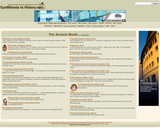
This parent guide supports parents in helping their child at home with the 6th grade Social Studies content.
- Subject:
- Social Studies
- Material Type:
- Reference Material
- Vocabulary
- Author:
- Kelly Rawlston
- Letoria Lewis
- Date Added:
- 10/12/2022

This parent guide supports parents in helping their child at home with the 6th grade Social Studies content.

This resource accompanies our Rethink 6th Grade Social Studies course. It includes ideas for use, ways to support exceptional children, ways to extend learning, digital resources and tools, tips for supporting English Language Learners and students with visual and hearing impairments. There are also ideas for offline learning.

Containing more than 50 articles from the award-winning Tar Heel Junior Historian magazine and over 40 lesson plans, this multidisciplinary Educator Notebook will enrich your exploration of North Carolina and American history with diverse perspectives. This resource's link takes you to a very short form that gives you free downloadable access to the complete PDF book.

A website resource that provides facts and data that documents the forced removal of enslaved persons from Africa and their arrival to North Carolina.

This lesson concentrates on Anne Frank as a writer. After a look at Anne Frank the adolescent, and a consideration of how the experiences of growing up shaped her composition of the Diary, students explore some of the writing techniques Anne invented for herself and practice those techniques with material drawn from their own lives.

This inquiry uses the ancient and modern Olympic games as a context for students to explore the compelling question "Are the Olympics about more than sports?" Students investigate the ancient and modern Olympics using a range of historical and secondary sources to learn more about the historical and mythological origins of the games; the rebirth of the games in France; and the broader goals of the Olympics, including nurturing the arts.

This web site allows students to view parts of the Bayeux Tapestry which tells the story of early Enligh History through a series of pictures. The activities attached to it allow students to create their own tapestry story along with the creation of objects from the time period. There are also suggestions for ways to tie the tapestry in with other subject areas.

This lesson provides students with tools to analyze primary source newspaper articles about the Great War (1914"“1917) in order to understand public opinion regarding the U.S. entry into the war from multiple perspectives.

This exhibition explores what it has meant to be a citizen throughout a millennium of British history. Click through to find full documents from each time period, as well as a quiz page.

In this lesson, students will read letters written during the Civil War. Referring to their knowledge about the Civil War, they’ll develop a clear understanding of the message of the letter. They will edit the letters for mechanics and create a dramatic reading based on their letter. Then students will create their own Civil War dramas, using a fictional letter they create.

In this activity, students will read an excerpt from Kennedy's speech about space exploration and answer a series of comprehension questions.

In this lesosn, students will analyze various resources in order to learn about the history of the assassination of Julius Caesar.

Drawing on the resources of the Library of Congress's Printed Ephemera Collection, this lesson helps students experience the news as the colonists heard it: by means of broadsides, notices written on disposable, single sheets of paper that addressed virtually every aspect of the American Revolution.

In this lesson, students will analyze 16 political cartoons drawn by Clifford and Jim Berryman during the early to mid-20th century. They will search through the Constitution and associate each cartoon with a specific clause. Through networking exercises, students will analyze all 16 cartoons and read the entire Constitution. They will learn about the outline and structure of the Constitution, as well as the content of many of its clauses.

This exhibition covers the themes of crime, prevention, and punishment during different time periods. There are 12 galleries altogether, each with a key question, a worksheet, and a number of case studies.

Students read and discuss the Founding Fathers of our country indulgence in gripe sessions. In fact, a list of grievances comprises the longest section of the Declaration of Independence; however, the source of the document's power is its firm philosophic foundation. You can capitalize on the inclination of your students to complain to increase student awareness of the precedents behind the Declaration of Independence. Students will summarize the contributions of the "Founding Fathers" to the development of our county as well as explain how key historical figures exemplified values of American democracy.

In this lesson, students are introduced to the genre of folktales and engage in a study of several Russian folktales. They are asked to read the tales aloud, and then to fill in a chart about each one. Next, they analyze the charts, answering questions about the folktales’ setting, main characters, and "uniquely Russian" attributes. They also compare and contrast Russian folktales with folktales they may have heard as young children. The lesson culminates with a writing assignment in which students will analyze the folktales or create their own.

This page provides a variety of primary and secondary resources related to ancient civilizations.

One of the most famous political speeches on freedom in the twentieth century was delivered by Franklin Delano Roosevelt in his 1941 State of the Union message to Congress. This lesson examines the rhetorical use of "freedom" with the objective of encouraging students to glimpse the broad range of hopes and aspirations that are expressed in the call of and for freedom.

This lesson examines primary sources from the Foundling Hospital in London and poses questions about how things were run and what life was like for a child under their care.